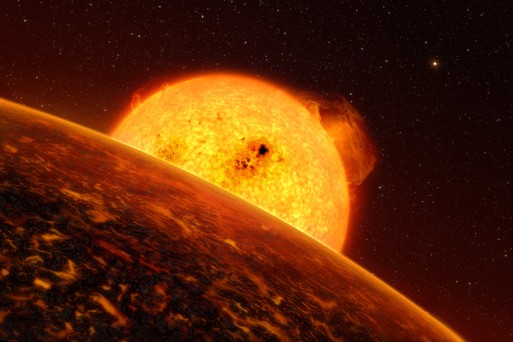Molten rock falls from the sky as rain on exoplanet COROT-7b, reports Ian Randall
Geoscientist Online 25 November 2009

Orbiting a mere 1.6 million miles from its star COROT-7 (a dwarf star in the constellation Monoceros), exoplanet COROT-7b is gravitationally locked: one face always looks onto the star, and the other away. The face closest to the star has a surface temperature of around 2326 degrees centigrade; at these temperatures, which are 2650 degrees hotter than the opposing side, surface rocks are vaporised. The planet is about twice the size of the Earth.
Scientists writing in The Astrophysical Journal believe that COROT-7b’s atmosphere is formed from this released, gaseous, rock material. As weather fronts pass across the planet’s surface, rock condenses and rains down into molten pools of lava that coat the landscape below.
The composition of the material precipitated depends on the altitude of the rain, with different rock fractions being precipitated according to their boiling point. At the top of the atmosphere, potassium and sodium are retained as high gas clouds due to their relatively low boiling points.
COROT 7b’s density was estimated in August using data gained through the discovery of COROT-7c, a second planet within the system. It is believed COROT-7b has a density similar to that of the Earth, suggesting that it is probably also composed of siliceous rocks. While it may share similarities with the Earth in that regard, and is in fact the most “Earth-like” exoplanet known, it appears to possess none of the compounds that make up our own planet’s atmosphere.
Laura Schaefer and Dr Bruce Fegley (Washington University) used MAGMA, a computer program originally designed to show the assemblages of minerals that are stable under given conditions, to undertake the thermochemical equilibrium calculations required to model COROT-7b’s unusual atmosphere. Four different simulations were run, each using a different possible starting composition for the planet. Fegley said: "We got essentially the same result in all four cases”. Scientists now say that most of the planet’s atmosphere is composed of oxygen, potassium, silicon monoxide and sodium. These compounds are all liberated from the rock during vaporisation.
COROT-7b also lays claim to having the smallest orbital period of any known planet - a mere 20 hours. Most of the other 400-odd exoplanets (also known by the unfortunate term “extra-solar”) known to science are gas giants that orbit close to their parent stars. COROT-7b was discovered in February by the French and European space agencies’ COROT space telescope, when a variation in the brightness of its parent star – caused by the planet’s transit - was first noted.
There has been some discussion over naming COROT-7b. “Icarus”, the Greek mythological character, son of the craftsman Daedalus (who, in trying to fly out of Crete before EasyJet, plummeted to his death when he got too close to the Sun) has been mooted. However this colourful idea is probably too rich for the blood of the International Astronomical Union, which remains keen to refer to planets by their parent star, “to avoid confusion”.